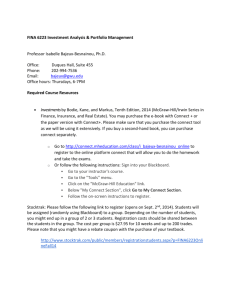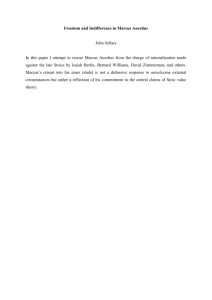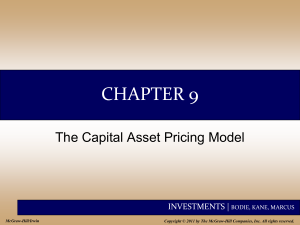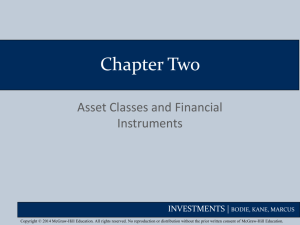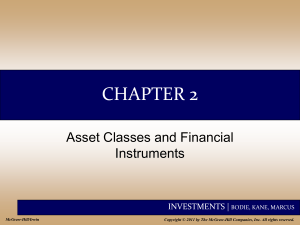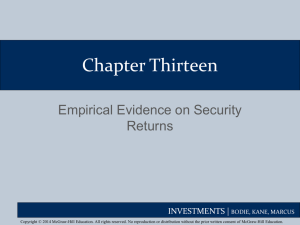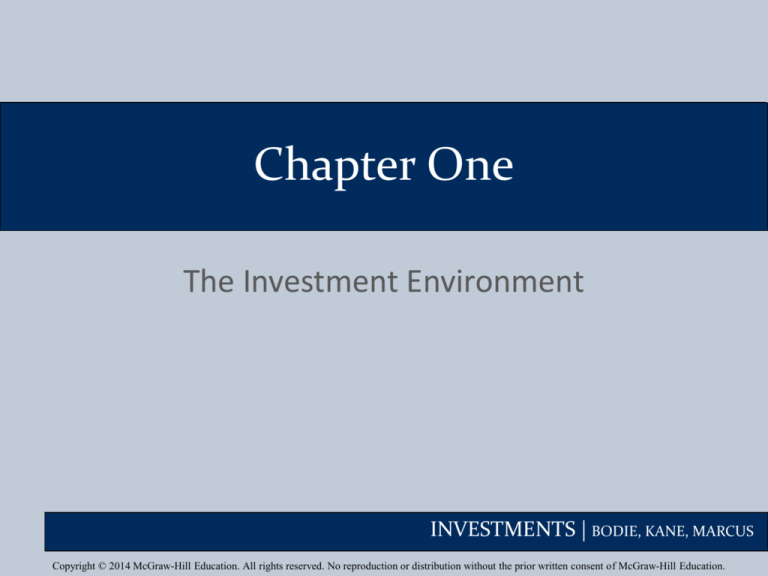
Chapter One
The Investment Environment
INVESTMENTS | BODIE, KANE, MARCUS
Copyright © 2014 McGraw-Hill Education. All rights reserved. No reproduction or distribution without the prior written consent of McGraw-Hill Education.
Chapter Overview
• Role of financial assets in the economy: Real
vs. financial assets
• Risk–return trade-off and the efficient pricing
• Financial crisis 2008
• Connections between the financial system
and the “real” side of the economy
• Lessons learned for evaluating systemic risk
1-2
INVESTMENTS | BODIE, KANE, MARCUS
Real Assets vs. Financial Assets
1-3
Real Assets
Financial Assets
• Determine the
productive capacity and
net income of the
economy
• Examples: Land,
buildings, machines,
knowledge used to
produce goods and
services
• Claims on real assets,
contribute only indirectly to
the productive capacity of the
economy, by allowing optimal
allocation of funds and
separation of ownership and
management.
• Examples: Stocks, bonds
• Don’t represent society’s
wealth.
INVESTMENTS | BODIE, KANE, MARCUS
Real Assets vs. Financial Assets
1-4
Real Assets
Financial Assets
• Produce goods and
services
• Allocate income and wealth
among investors.
• Allows transfer of funds from
today to the future.
• Invest now and consume
tomorrow.
• Are created and destroyed in
the ordinary course of
business.
INVESTMENTS | BODIE, KANE, MARCUS
Financial Assets
• Fixed income or debt
• Promise either a fixed stream of income or a
stream of income determined by a specified
formula
• Common stock or equity
• Represent an ownership share in the corporation
• Derivative securities
• Provide payoffs that are determined by the prices
of other assets
1-5
INVESTMENTS | BODIE, KANE, MARCUS
Other Types of Investment
• Investment in currency
• Investment in real assets through commodity
futures
• Corporations invest in the commodity futures
to hedge the risk
1-6
INVESTMENTS | BODIE, KANE, MARCUS
Financial Markets and the Economy
• The Informational Role
• Capital flows to companies with best prospects
• Consumption Timing
• Use securities to store wealth and transfer
consumption to the future
• Allocation of Risk
• Investors can select securities consistent with
their tastes for risk, which benefits the firms that
need to raise capital as security can be sold for the
best possible price
1-7
INVESTMENTS | BODIE, KANE, MARCUS
Financial Markets and the Economy
• Separation of Ownership and Management
• Agency problems arise when managers start pursuing
their own interests instead of maximizing firm's value
• Mechanisms to mitigate agency problems:
• Tie managers' income to the success of the firm (stock
options)
• Monitoring from the board of directors
• Monitoring from the large outside investors and
security analysts
• Takeover threat
1-8
INVESTMENTS | BODIE, KANE, MARCUS
The Investment Process
• Portfolio: Collection of investment assets.
• Asset allocation
• Choice among broad asset classes
• Security selection
• Choice of securities within each asset class
1-9
INVESTMENTS | BODIE, KANE, MARCUS
The Investment Process
• “Top-down” approach
• Asset allocation followed by security analysis to
evaluate which particular securities to be included
in the portfolio
• “Bottom-up” approach
• Investment based solely on the priceattractiveness, which may result in unintended
heavy weight of a portfolio in only one or another
sector of the economy
1-10
INVESTMENTS | BODIE, KANE, MARCUS
Markets Are Competitive
• Risk-Return Trade-Off
• Higher-risk assets are priced to offer higher
expected returns than lower-risk assets
• Efficient Markets
• In fully efficient markets when prices quickly
adjust to all relevant information, there should be
neither underpriced nor overpriced securities
1-11
INVESTMENTS | BODIE, KANE, MARCUS
Markets Are Competitive
• Passive Management
• Holding a highly diversified portfolio
• No attempt to find undervalued securities
• No attempt to time the market
• Active Management
• Finding mispriced securities
• Timing the market
1-12
INVESTMENTS | BODIE, KANE, MARCUS
The Players
• Demanders of capital – Firms
• Suppliers of capital – Households
• Governments – Can be both borrowers or
lenders
1-13
INVESTMENTS | BODIE, KANE, MARCUS
The Players
• Financial Intermediaries: Pool and invest funds
• Investment Companies
• Banks
• Insurance companies
• Credit unions
1-14
INVESTMENTS | BODIE, KANE, MARCUS
Universal Bank Activities
1-15
Investment Banking
Commercial Banking
• Underwrite new
securities issues
• Sell newly issued
securities to public in the
primary market
• Investors trade previously
issued securities among
themselves in the
secondary markets
• Take deposits and make
loans
INVESTMENTS | BODIE, KANE, MARCUS
Financial Crisis of 2008
• Antecedents of the Crisis:
• “The Great Moderation”: A time in which
the U.S. had a stable economy with low
interest rates and a tame business cycle
with only mild recessions
• Historic boom in housing market
1-16
INVESTMENTS | BODIE, KANE, MARCUS
1-17
Jul-08
Jan-08
Jul-07
Jan-07
6
Jul-06
7
Jan-06
Jul-05
Jan-05
Jul-04
Jan-04
Jul-03
Jan-03
Jul-02
Jan-02
Jul-01
Jan-01
Jul-00
Jan-00
Jul-99
Jan-99
Jul-98
Jan-98
Jul-97
Jan-97
Jul-96
Jan-96
Interest Rates (%)
Figure 1.1 Short-Term LIBOR and Treasury-Bill
Rates and the TED Spread
8
3-month LIBOR
3-month T-bill
TED spread
5
4
3
2
1
0
INVESTMENTS | BODIE, KANE, MARCUS
Figure 1.3 The Case-Shiller Index of U.S.
Housing Prices
250
Index (January 2000 = 100)
200
150
100
50
1-18
2013
2011
2009
2007
2005
2003
2001
1999
1997
1995
1993
1991
1989
1987
0
INVESTMENTS | BODIE, KANE, MARCUS
Changes in Housing Finance
1-19
Old Way
New Way
• Local thrift institution made
mortgage loans to
homeowners
• Thrift’s major asset: A
portfolio of long-term
mortgage loans
• Thrift’s main liability:
Deposits
• “Originate to hold”
• Securitization: Fannie Mae
and Freddie Mac bought
mortgage loans and
bundled them into large
pools
• Mortgage-backed securities
are tradable claims against
the underlying mortgage
pool
• “Originate to distribute”
INVESTMENTS | BODIE, KANE, MARCUS
Changes in Housing Finance
• Securitization: Buying mortgage loans from
originators and bundling them into mortgage-backed
securities
• Replacement of low-risk conforming mortgages with
nonconforming “subprime” loans
• Trend toward low-documentation and then nodocumentation loans and rising allowed leverage on
home loans (loan-to-value ratio)
• Low adjustable-rate mortgages (ARMs) that “maxed
out” borrowers' paying capacity at low rates
1-20
INVESTMENTS | BODIE, KANE, MARCUS
Figure 1.4 Cash Flows in a Mortgage PassThrough Security
1-21
INVESTMENTS | BODIE, KANE, MARCUS
Mortgage Derivatives
• Collateralized debt obligations (CDOs)
• Mortgage pool divided into slices or tranches to
concentrate default risk
• Senior tranches: Lower risk, highest rating (AAA)
• Junior tranches: High risk, low or junk rating
• Estimated ratings significantly underestimated the
inherent risk
1-22
INVESTMENTS | BODIE, KANE, MARCUS
Why Was Credit Risk Underestimated?
• Default probabilities were estimated on the
historical data covering the rising housing
market
• Geographic diversification did not reduce risk
as much as anticipated
• Agency problems with rating agencies
1-23
INVESTMENTS | BODIE, KANE, MARCUS
Credit Default Swap (CDS)
• A CDS is an insurance contract against the
default of the borrower
• Investors bought sub-prime loans and used CDSs
to insure their safety
• Some big swap issuers did not have enough capital
to back their CDSs when the market collapsed
resulting in the failure of CDO insurance
1-24
INVESTMENTS | BODIE, KANE, MARCUS
Rise of Systemic Risk
• Systemic Risk: A potential breakdown of the
financial system in which problems in one
market spill over and disrupt others.
• One default may set off a chain of further defaults
• Waves of selling may occur in a downward spiral
as asset prices drop
• Potential contagion from institution to institution,
and from market to market
1-25
INVESTMENTS | BODIE, KANE, MARCUS
Rise of Systemic Risk
• Banks had a mismatch between the maturity
and liquidity of their assets and liabilities
• Liabilities were short and liquid
• Assets were long and illiquid
• Constant need to refinance the asset portfolio
• Banks were very highly levered, giving them
almost no margin of safety
1-26
INVESTMENTS | BODIE, KANE, MARCUS
Rise of Systemic Risk
• Investors relied too much on credit
enhancement through structured products
like CDS
• CDS traded mostly over-the-counter, with no
posted margin requirements and little
transparency
• Opaque linkages between financial
instruments and institutions
1-27
INVESTMENTS | BODIE, KANE, MARCUS
The Shoe Drops
• 2000-2006: Sharp increase in housing prices
caused many investors to believe that
continually rising home prices would bail out
poorly performing loans
• 2004: Interest rates began rising
• 2006: Home prices peaked
• 2007: Housing defaults and losses on
mortgage-backed securities surged
1-28
INVESTMENTS | BODIE, KANE, MARCUS
The Shoe Drops
• 2008: Troubled firms include Bear Stearns,
Fannie Mae, Freddie Mac, Merrill Lynch,
Lehman Brothers, and AIG
• Money market breaks down
• Credit markets freeze up
• Federal bailout to stabilize financial system
1-29
INVESTMENTS | BODIE, KANE, MARCUS
The Dodd-Frank Reform Act
• Mechanisms to mitigate systemic risk
• Stricter rules for bank capital, liquidity, and risk
management practices
• Increased transparency, especially in derivatives
markets (eg.: standardize CDS contracts so they
can trade in centralized exchanges)
• Office of Credit Ratings within the SEC to oversee
the credit rating agencies
1-30
INVESTMENTS | BODIE, KANE, MARCUS

